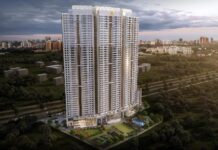New Delhi, June 05, 2017: The Property Times : How does design impact functionality as well as comfort of a space?
Dilip Nadig : As an art, architecture is more than satisfying the purely functional requirements of a building program. Fundamentally, the physical manifestations of architecture accommodate human activity. However, the arrangement and ordering of forms and spaces also determine how architecture might elicit responses, and communicate meaning. Form and space are presented not as ends in themselves but as means to solve a problem in response to conditions of function, purpose, and context—that is, architecturally
The Property Times : Does design have to be radically different or merely warm and appealing to elicit interest from a prospective client?
Dilip Nadig ; The real problem is the impulse to be avant-garde, which severs our ties with the past. Avant-garde buildings can occasionally be quite beautiful. But the win-loss ratio is horrible; unacceptable. To get those very, very few successful, glorious, modernist buildings, you sacrifice an enormous percentage of failed buildings at every level, because each designer tries to reinvent the wheel instead of improving on established forms.
I’m very suspicious of invention. We’d better be at least a little suspicious of anything brand new, of sharp breaks with the evolved past, because on the scale on which we urban designers work–which is the very fabric of a city–failure can be cataclysmic. When a community plan fails, it’s essentially permanent. It can harm thousands of people over generations. So you have to be conservative in community design. There are very good historical reasons to be sceptical.
So in a nutshell, in case of community design we would prefer warm and appealing design rather than a radical / avant-garde approach.
The Property Times : What elements in design a buyer essentially looks for when planning the purchase of a residence?
Dilip Nadig ; Usually, any Indian buyer looks broadly into following parameters while selecting a property.
· Location & convenience factor.
· Rate of the property in comparison to the market trends in the vicinity.
· Surrounding neighbourhood.
· Amenities offered by the builder.
· Building aesthetics.
· Expected rate of appreciation in future.
·
From a design perspective, the buyer would generally be concerned whether the design of the apartment would suit or enhance his lifestyle. Vaasthu in most cases nowadays plays an important role. Other parameters of light, ventilation, carpet area efficiency are also factored into while selection of an apartment.
The Property Times : What parameters need to be addressed to come up with the right design that is universally appealing?
Dilip Nadig ; Good collaboration is the only way to achieve ‘the right design’ viably in a cost-constrained world, especially in public projects and frameworks where value for money is critical. It is the way we balance high aspirations for design quality against very real budgetary, programmatic and geographical constraints. It requires teamwork and cooperation. For us architects treading a difficult path between aesthetic judgement, meeting the brief and cost control, it takes exceptional skill and commitment. More than anything, we respect Clients who listen to us without compromising on design creativity.
The Property Times : Can design have a role in triggering demand where none existed or impact positively fence sitters?
Dilip Nadig ; Good design can play a significant role in triggering demand where none existed, but is dependent on the scale of the project and its associated infrastructure. It has long been known that ‘good’ architecture and quality design are public goods, as they have been shown to increase surrounding property values, create a sense of community, and provide a catalyst for future development.
There are obvious social benefits to good architecture; neighbourhood gentrification, increased property values, increased tourism and foottraffic, and increased safety, to name a few. However, most buildings are funded and developed by private individuals, and not from society as a whole. This obviously creates the potential for a free-rider problem, as there is potentially no incentive for the neighbour, who though will benefit from increased property values, to pay for good architecture.
The Property Times : Can you talk about your designs where you have come up such differential approach that has triggered a positive reaction from a prospective client?
Dilip Nadig ; One of our projects under commission recently is the Vaishnavi Oasis, off the Kanakapura Road in Bangalore.
When we first pitched in for this project, we were aware that this particular location of the site would cater to mid-segment only. Additionally there were several other projects from leading developers in the vicinity. In order to ensure that our design stood out from the crowd, we proposed three towers, each connected at the roof level by a “sky club” and an infinity pool at a height of about 40m from the podium. The intention was to increase the aspirational value of the project, to compete with identical pricing of the competition.
The design was widely appreciated by Team Vaishnavi and the marketing strategy was largely based on the design along with the amenities.
Corporate Comm India (CCI Newswire)




















